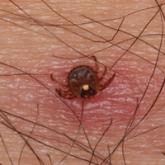Environmental Dermatology

What’s Eating You? Cheyletiella Mites
Cheyletiella are nonburrowing mites commonly found on rabbits, dogs, and cats. The mites have been known to cause disease in humans, ranging from...
From the Department of Dermatology and Dermatologic Surgery of the Medical University of South Carolina, Charleston.
The authors report no conflict of interest.
All images are in the public domain.
Correspondence: Megan E. Hohenberger, MD (mehohenberger@gmail.com).

Belonging to the Trombiculidae family of mites, chigger specifically refers to the larval stage of the mite’s life cycle when it is able to bite its host. Although humans act as an accidental host, chiggers will latch on to the skin and their feeding process leads to localized inflammation and irritation. In most cases, these pruritic erythematous papules and papulovesicles are self-healing within a couple weeks, so only symptomatic relief is required as necessary by means of topical antipruritics, oral antihistamines, topical corticosteroids, or an intralesional triamcinolone acetonide injection in severe instances. The best practice, however, is to take preventative measures by completely covering one’s skin and applying products containing DEET to the skin and clothing when traveling in infested areas.
Practice Points
Chiggers belong to the Trombiculidae family of mites and also are referred to as harvest mites, harvest bugs, harvest lice, mower’s mites, and redbugs.1 The term chigger specifically describes the larval stage of this mite’s life cycle, as it is the only stage responsible for chigger bites. The nymph and adult phases feed on vegetable matter. Trombiculid mites are most often found in forests, grassy areas, gardens, and moist areas of soil near bodies of water. Trombicula alfreddugesi is the most common species in the United States, and these mites mainly live in the southeastern and south central regions of the country. Conversely, Trombicula autumnalis is most predominant in Western Europe and East Asia.1
The life cycle of the mite includes the egg, larval, nymphal, and adult stages.2 Due to their need for air humidity greater than 80%, mites lay their eggs on low leaves, blades of grass, or on the ground. They spend most of their lives on vegetation no more than 30 cm above ground level.3 Eggs remain dormant for approximately 6 days until the hatching of the prelarvae, which have 6 legs and are nonfeeding. It takes another 6 days for the prelarvae to mature into larvae. Measuring 0.15 to 0.3 mm in length, mite larvae are a mere fraction of the size of adult mites, which generally are 1 to 2 mm in length, and are bright red or brown-red in color (Figure 1).
The biting larvae have many acceptable hosts including turtles, toads, birds, small mammals, and humans, which act as accidental hosts. Larvae remain on vegetation waiting for a suitable host to pass by so they may attach to its skin and remain there for several days. In the exploration for an ideal area to begin feeding (eg, thin epidermis,4 localized increased air humidity5), larvae can travel extensively on the skin; however, they often are stopped by tight-fitting sections of clothing (eg, waistbands), so bites are mostly found in clusters. To feed, mite larvae latch onto the skin using chelicerae, jawlike appendages found in the front of the mouth in arachnids.6 They then inject digestive enzymes that liquefy epidermal cells on direct contact, which results in the formation of a stylostome from which the mites may suck up lymph fluid and broken down tissue.7 Although the actual initial bite is painless, this feeding process leads to the localized inflammation and irritation noticed by infested patients.8
The classic clinical presentation includes severe pruritus and cutaneous swelling as well as erythema caused by the combination of several factors, such as enzyme-induced cellular mechanical damage, human immune response, and sometimes a superimposed bacterial infection. Papules and papulovesicles appear in groups, most commonly affecting the legs and waistline (Figure 2).9 Itching generally occurs within hours of larval latching and subsides within 72 hours. Cutaneous lesions typically take 1 to 2 weeks to heal. In some rare cases, patients may react with urticarial, bullous, or morbilliform eruptions, and the inflammation and pruritus can last for weeks.6 Summer penile syndrome has been noted in boys who display a local hypersensitivity to chigger bites.10 This syndrome represents a triad of penile swelling, dysuria, and pruritus, which lasts for a few days to a few weeks.

Cheyletiella are nonburrowing mites commonly found on rabbits, dogs, and cats. The mites have been known to cause disease in humans, ranging from...

Amblyomma americanum, also known as the lone star tick, is found in much of the eastern United States. Since the mid-20th century, the lone star...
A 44-year-old woman presented with a localized patch of hair loss on the frontal scalp of several month’s duration. She had been bitten by a tick...
